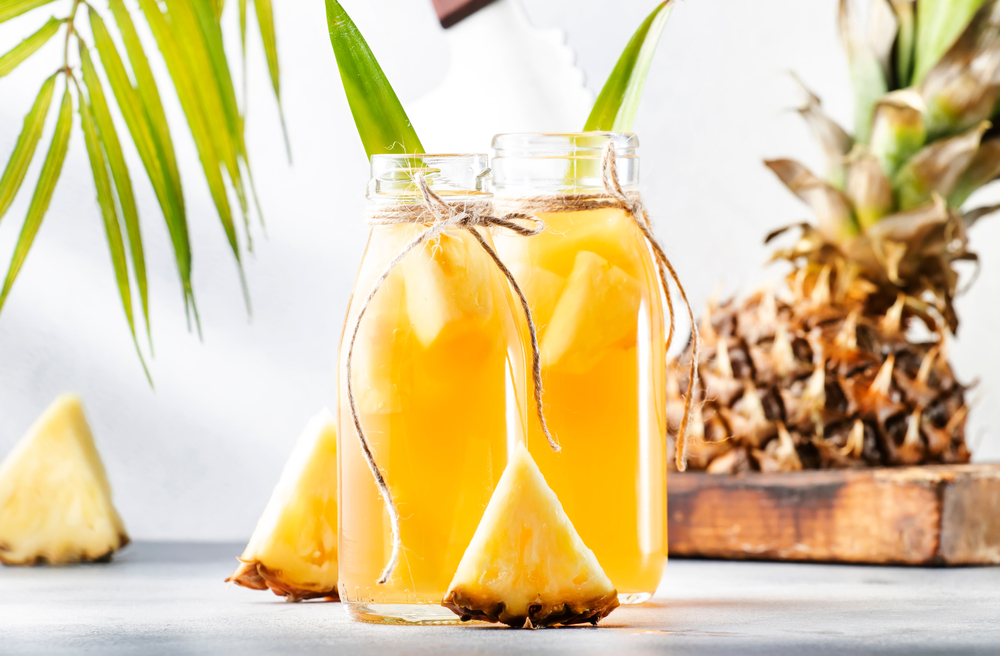That pineapple top you usually toss in the trash? It might be the key to your next gut health breakthrough. A surprisingly simple home fermentation process using pineapple scraps has exploded across social media, with devotees claiming benefits ranging from improved digestion to enhanced immune function. While it sounds like just another passing wellness fad, this particular trend has caught the attention of microbiome researchers for legitimate scientific reasons.
Unlike many internet health crazes, fermented pineapple water—often called “pineapple tepache” in its traditional Mexican form—combines several evidence-backed gut health mechanisms in one simple home preparation. The unique components in pineapple interact with natural fermentation processes to create a probiotic-rich drink containing enzymes, beneficial microbes, and prebiotic compounds that may benefit digestive health in ways commercial products can’t match.
Let’s explore what happens during pineapple water fermentation, why this particular fruit creates unique gut health properties, and whether the dramatic benefits some users report have scientific backing or represent typical internet exaggeration. The fermented pineapple water phenomenon reveals fascinating insights into how traditional food practices sometimes anticipate scientific discoveries about our microbiome by centuries.
The fermentation magic that transforms pineapple
The conversion of ordinary pineapple scraps into a gut-supportive tonic involves several distinct fermentation stages that produce specific beneficial compounds through different microbial activities.
Wild fermentation initiation begins naturally without added starters due to pineapple’s unique surface microbiome. The fruit’s skin harbors Saccharomyces yeasts, lactic acid bacteria, and specialized microbes adapted to the fruit’s high acid and enzyme content. This natural microbial community explains why pineapple ferments more reliably than many other fruits without requiring commercial starters or extensive sterilization procedures.
The primary fermentation phase lasting approximately 24-48 hours creates a dramatic shift in microbial populations. Initial rapid growth of yeasts converts simple sugars into alcohol, carbon dioxide, and aromatic compounds. This creates the characteristic bubbling activity visible during early fermentation along with the development of a slightly sweet, tangy aroma distinctly different from fresh pineapple.
Secondary fermentation dominated by lactic acid bacteria typically begins around day 2-3. These bacteria, primarily Lactobacillus and Leuconostoc species, metabolize both remaining sugars and the alcohol produced by yeasts, creating lactic acid that drops the pH to approximately 3.8-4.2. This acidification creates the characteristic sour notes in properly fermented pineapple water while simultaneously establishing a selective environment that inhibits potentially harmful microbes.
Enzymatic bioactivation represents a unique aspect of pineapple fermentation compared to other fruits. The bromelain enzymes naturally present in pineapple interact with the fermentation process, creating partially digested protein compounds and bioactive peptides not found in other fermented beverages. These compounds contribute to both the digestive benefits and the distinctive flavor profile that develops during longer fermentation periods.
Micronutrient conversion during fermentation enhances the bioavailability of pineapple’s natural vitamins and minerals. The fermentation process breaks down antinutrient compounds while microbial activity creates more bioavailable forms of manganese, vitamin C, and B vitamins. This enhanced nutrient profile explains why traditional cultures often valued fermented versions of tropical fruits beyond their preservation benefits.
The probiotic powerhouses uniquely suited to pineapple
Pineapple fermentation naturally selects for specific beneficial microbial strains with particular relevance to gut health through several selective mechanisms.
Bromelain-resistant bacterial strains represent a special subset of probiotics that thrive during pineapple fermentation. Since bromelain naturally digests proteins, bacteria that survive this enzyme-rich environment typically possess specialized cellular characteristics that also help them survive stomach acid and digestive enzymes in the human gut. This natural selection process explains why pineapple-derived probiotics often show superior gut colonization compared to those from other fermented foods.
Leuconostoc mesenteroides proliferation occurs prominently in properly fermented pineapple water. This particular bacterial species produces exopolysaccharides (EPS)—complex sugars that both feed beneficial gut bacteria and appear to strengthen intestinal barrier function. Research shows these compounds may help prevent the intestinal permeability issues increasingly linked to various inflammatory and autoimmune conditions.
Saccharomyces cerevisiae var. boulardii—a beneficial yeast with extensive clinical research supporting its gut health benefits—naturally occurs on pineapple skins and multiplies during early fermentation stages. Unlike many bacterial probiotics, this yeast survives gastric acid exposure almost completely, allowing it to reach the intestines intact. Clinical studies show this organism effectively addresses antibiotic-associated diarrhea and helps restore microbiome balance after disruptions.
Lactobacillus plantarum strains isolated from traditional pineapple ferments show particularly impressive antimicrobial properties against common intestinal pathogens. Research demonstrates these specific strains produce natural antibacterial compounds that selectively target potential pathogens while sparing beneficial species—essentially acting as a natural, targeted antibiotic that doesn’t disrupt the broader gut ecosystem.
Acetic acid bacteria appear in later fermentation stages, converting alcohol to acetic acid while producing cellulose-like compounds that function as powerful prebiotics. These bacteria, similar to those in kombucha and apple cider vinegar, create a matrix that appears to help beneficial microbes adhere to intestinal walls and establish more permanent colonies rather than passing through the digestive tract without colonizing.
The enzyme activity that separates pineapple from other ferments
Beyond probiotics, pineapple’s unique enzymatic properties create distinctive gut health benefits when fermented through several specific mechanisms.
Bromelain concentration actually increases during early fermentation phases as bound forms of the enzyme are released through microbial activity. This proteolytic enzyme complex has been extensively studied for its anti-inflammatory properties and ability to break down undigested protein compounds that can trigger digestive discomfort and immune reactions in the gut. Research shows bromelain helps digest protein fragments that may otherwise provoke immune responses in sensitive individuals.
Enzyme stability enhancement occurs through the fermentation process. The acidic environment created during fermentation helps preserve bromelain activity, while certain microbial byproducts appear to stabilize the enzyme against degradation. This preservation explains why properly fermented pineapple water maintains its digestive benefits longer than fresh pineapple juice, which loses enzymatic activity relatively quickly after preparation.
Synergistic enzyme-probiotic interactions create effects beyond what either component produces alone. Research indicates that bromelain appears to enhance probiotic colonization by breaking down biofilms and protein barriers that might otherwise prevent beneficial bacteria from establishing in the gut. This synergy explains why some studies show improved probiotic efficacy when administered alongside proteolytic enzymes like those in fermented pineapple.
Anti-inflammatory prostaglandin modulation has been documented with bromelain, particularly when combined with the organic acids produced during fermentation. This combination appears to selectively inhibit pro-inflammatory prostaglandins while preserving those with anti-inflammatory effects. This selective modulation helps explain the reported benefits for inflammatory digestive conditions that many fermented pineapple users describe.
Mucolytic properties unique to pineapple enzymes help break down excessive or overly viscous mucus in the digestive tract. This mucus-thinning effect can improve nutrient absorption and reduce habitats where opportunistic microbes may thrive protected by thick mucus layers. This property distinguishes pineapple ferments from many other probiotic foods that lack this mucolytic activity.
The prebiotic components that feed your microbiome
Beyond introducing beneficial microbes, fermented pineapple water contains several compounds that selectively nourish beneficial bacteria already present in your gut through distinct mechanisms.
FOS (fructooligosaccharides) content increases significantly during fermentation as complex carbohydrates in pineapple are partially broken down into these simpler prebiotic fibers. FOS selectively feeds Bifidobacteria species associated with reduced inflammation and improved barrier function in the intestines. This prebiotic transformation explains why fermented pineapple often produces fewer digestive side effects than consuming large amounts of fresh pineapple, which contains more intact fiber that can cause gas when rapidly fermented by gut bacteria.
Bromelain-digested protein fragments create unique peptide prebiotics not found in other fermented beverages. These partially digested proteins provide nitrogen sources that certain beneficial bacterial strains can utilize more efficiently than potential pathogens. This selective feeding advantage helps beneficial species outcompete potentially harmful bacteria in the competitive gut ecosystem.
Phenolic compound modifications during fermentation enhance their prebiotic activity. Pineapple’s natural polyphenols undergo biotransformation through microbial enzymes, creating derivatives with stronger prebiotic effects and improved bioavailability. Research shows these transformed compounds selectively promote growth of Akkermansia muciniphila—a beneficial bacterial species associated with metabolic health and reduced inflammation.
Resistant starch formation occurs during the cooling phase after active fermentation. The temperature fluctuations during fermentation and subsequent refrigeration convert some digestible starches into resistant forms that function as powerful prebiotics reaching the lower intestine intact. This resistant starch formation explains why traditional preparations typically include specific cooling protocols rather than immediate consumption after fermentation.
The microbiome-accessible sugar gradient created during partial fermentation provides feeding options for diverse beneficial species. Unlike commercial preparations that often contain either easily digested sugars (feeding upper-gut bacteria) or entirely indigestible fibers (feeding only lower-gut species), properly fermented pineapple water contains a spectrum of carbohydrates that nourish beneficial microbes throughout the entire digestive tract.
The bioactive compounds unveiled by fermentation
Fermentation transforms many compounds in pineapple into more potent bioactive forms through several microbial conversion processes.
Bromelain peptide fragments created during fermentation show enhanced anti-inflammatory activity compared to the intact enzyme. Microbial processing of bromelain creates smaller peptide units that can be absorbed directly through intestinal walls, allowing systemic anti-inflammatory effects beyond the digestive tract itself. These absorbable peptides help explain the whole-body benefits some users report beyond digestion.
Organic acid profile development creates powerful antimicrobial effects against potential pathogens. The specific blend of lactic, acetic, and citric acids produced during proper pineapple fermentation creates a selective antimicrobial environment that inhibits common digestive pathogens while allowing beneficial species to thrive. Research shows this acid combination particularly affects Escherichia coli and certain Salmonella strains without significantly impacting beneficial Lactobacillus and Bifidobacterium species.
Flavonoid transformation through microbial enzymes converts pineapple’s natural flavonoids into more bioavailable forms with enhanced activity. These transformed compounds show stronger antioxidant effects and improved ability to modulate specific inflammatory pathways in intestinal tissues. This bioactivation explains why fermented versions often show stronger anti-inflammatory effects than the same quantity of fresh fruit.
Short-chain fatty acid (SCFA) production increases significantly as fermentation progresses. These compounds—particularly butyrate, acetate, and propionate—serve as both fuel for intestinal cells and signaling molecules that regulate local immune function. SCFA production explains many of the barrier-strengthening and inflammation-modulating effects reported by regular consumers of properly fermented pineapple water.
Histamine degradation pathways activate during extended fermentation periods. Unlike many other fermented foods that can increase histamine levels (potentially problematic for sensitive individuals), properly fermented pineapple contains enzymes that actually break down histamine. This histamine-reducing effect explains why some people who react poorly to other fermented foods report tolerating or even benefiting from fermented pineapple water.
The traditional wisdom versus modern applications
Traditional fermentation techniques developed over centuries contain sophisticated understanding that modern science is only beginning to validate through several specific insights.
Tepache traditions in Mexican culture reveal precise fermentation parameters refined over generations. Traditional preparation specifies using pineapple rinds rather than flesh, precise sugar ratios adjusted for fruit ripeness, and specific environmental temperature considerations. Modern research confirms these parameters create optimal conditions for beneficial microbial succession while minimizing potential for pathogen growth or off-flavor development.
The three-day fermentation window emphasized in traditional practices has significant microbiological validation. This timeframe allows sufficient acid development for safety while preventing excessive alcohol production or acetic acid conversion that creates vinegar rather than a probiotic beverage. Microbiome analysis confirms this window maximizes probiotic diversity while maintaining palatability and safety—knowledge developed through observation centuries before microscopes existed.
Seasonal consumption patterns in traditional cultures reveal sophisticated understanding of body needs. Traditional practices often recommended fermented pineapple water particularly during seasonal transitions and periods of dietary change—precisely when modern research shows microbiome support proves most beneficial for immune function and digestive adaptation to new food sources.
Container material specifications in traditional recipes—typically clay or wooden vessels rather than metal—demonstrate empirical knowledge of how fermentation environments affect microbial communities. Modern research confirms that microscopic pores in traditional materials harbor beneficial starter cultures while trace minerals gradually released from clay provide optimal nutrition for probiotic species—factors not present in the glass or plastic containers often used in modern adaptations.
Taste-based quality assessment methods passed through generations contain sophisticated safety indicators disguised as flavor preferences. Traditional guidance to stop consumption if ferments develop certain flavor notes actually identifies potential pathogen presence or unhealthy microbial imbalances—essentially creating sensory safety testing without laboratory equipment.
The gut health claims versus scientific evidence
The explosion of interest in fermented pineapple water has generated numerous health claims ranging from plausible to exaggerated when evaluated against available scientific evidence.
Digestive enzyme supplementation represents one of the most scientifically supported benefits. The combination of natural pineapple enzymes and those produced during fermentation provides a broad-spectrum enzyme profile that research confirms can assist protein digestion and reduce symptoms of occasional digestive discomfort, particularly feelings of heaviness after protein-rich meals.
Leaky gut improvement claims have preliminary research support through several mechanisms. The combination of anti-inflammatory compounds, specific probiotic strains, and intestinal cell-nourishing short-chain fatty acids produced during pineapple fermentation creates conditions shown to enhance intestinal barrier integrity in laboratory studies, though human clinical trials specifically examining fermented pineapple for this purpose remain limited.
Inflammation modulation effects are well-supported by existing research on both bromelain and specific organic acids present in properly fermented pineapple water. Multiple clinical studies demonstrate anti-inflammatory effects of these compounds, particularly for digestive tract inflammation, though claims regarding systemic inflammatory conditions require more specific clinical validation.
Microbiome diversity enhancement has strong theoretical support based on the combination of diverse probiotic strains and prebiotic compounds present in the fermented beverage. Preliminary studies on similar fermented products show measurable increases in beneficial species and overall diversity, though large-scale human trials specifically examining fermented pineapple’s impact on microbiome composition are still emerging.
Immune modulation claims have partial scientific validation. The combination of specific probiotic strains, bioactive peptides, and organic acids present in fermented pineapple has demonstrated immune-modulating effects in laboratory studies. However, claims about specific immune conditions or enhanced resistance to particular illnesses require more rigorous clinical evaluation beyond the preliminary evidence currently available.
The preparation nuances that maximize benefits
Specific preparation details significantly impact the health properties of fermented pineapple water through several critical factors that influence microbial development and bioactive compound production.
Organic versus conventional pineapple creates meaningful differences in fermentation outcomes. Conventional pineapples often undergo antimicrobial treatments that can significantly impair the natural microbial community needed for proper fermentation. Research shows organic pineapples typically carry more diverse and abundant beneficial microbial populations that initiate faster, more complete fermentation with greater probiotic diversity in the final product.
Fermentation vessel selection substantially affects both safety and bioactive compound production. Traditional clay or glass containers provide neutral surfaces that don’t react with acids produced during fermentation, while certain metals can leach into the acidic environment, potentially creating both off-flavors and compounds that inhibit beneficial microbial growth. The vessel’s width-to-height ratio also affects oxygen exposure, influencing which microbial species dominate during different fermentation phases.
Temperature control creates perhaps the most significant impact on health properties. Fermentation at 75-80°F (24-27°C) optimizes beneficial Lactobacillus and Leuconostoc growth while limiting potential pathogen development. Lower temperatures slow fermentation and may allow yeasts to dominate excessively, while higher temperatures risk undesirable bacterial species that produce off-flavors and potentially harmful byproducts.
Sugar source and quantity dramatically affect both safety and probiotic diversity. Traditional proportions of approximately 1/4 cup unrefined sugar per quart of water provide sufficient fermentable carbohydrates without excessive alcohol production or extreme acidification. Studies show unrefined sugar sources like piloncillo or panela provide trace minerals that support more diverse probiotic development compared to highly refined white sugar.
Fermentation duration timing significantly impacts the balance between beneficial compounds and potential irritants. The optimal 2-4 day window at room temperature allows sufficient development of probiotics and organic acids while preventing excessive alcohol, acetic acid, or histamine accumulation that might cause digestive discomfort in sensitive individuals. This timing explains why traditional recipes emphasize specific visual and aromatic cues to determine optimal completion rather than rigid timeframes.
Fermented pineapple water represents a fascinating intersection of traditional food wisdom and modern microbiome science. While not the miracle cure sometimes portrayed in viral social media posts, the scientific analysis of this traditional beverage reveals sophisticated biochemical properties that legitimate gut health benefits through multiple complementary mechanisms.
What makes this particular ferment especially valuable in the modern context is its accessibility and sustainability—transforming food parts typically discarded into a therapeutic food with minimal equipment or specialized knowledge required. This practical aspect, combined with the growing scientific validation of fermentation’s role in gut health, explains why this traditional practice has found renewed relevance in contemporary wellness culture.
As research into the microbiome continues revealing connections between gut health and virtually every body system, traditional fermentation practices like pineapple tepache provide both practical tools for personal health and fascinating windows into how traditional cultures developed sophisticated nutritional wisdom through observation and intergenerational knowledge long before modern scientific validation was possible.
If you’re considering trying fermented pineapple water, approaching it as a traditional food rather than a miracle cure—introducing it gradually, observing your body’s response, and integrating it as part of a diverse approach to nutrition—offers the most balanced way to explore its potential benefits while respecting both traditional wisdom and scientific understanding.


















